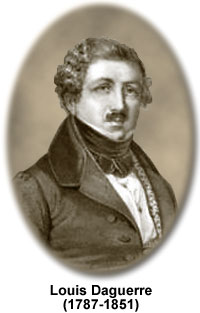Louis-Jacques-Mandé Daguerre
(1787-1851)

Born near Paris, France on November 18, 1787, Louis-Jacques-Mandé Daguerre was to become both a painter and the inventor of the first successful form of photography. Originally trained as an architect, Daguerre later became a pupil of E. M. Degotti at the Paris Opera and a thriving scene painter. In 1822, working with Charles Boulton, Daguerre helped develop the Diorama, a Paris illusionistic exhibition that contained paintings on large translucent screens, which seemed to come to life with skillful light manipulation.
As an artist, Daguerre was interested in creating realistic renderings and utilized a camera obscura to aid his efforts. In hopes of simplifying the process, he became intrigued with the idea of permanently fixing an image chemically, as were many others during the period. Daguerre began his initial explorations alone, but soon was introduced by his optician to Joseph-Nicephore Niepce, who was working towards a similar goal. Hesitant at first, the pair decided to collaborate, primarily concentrating on silver-plated copper sheets treated with iodine to make them sensitive to light. A view from Niepce's studio window taken in 1826 is considered the oldest existing photograph, but the process they used at that time was not practical for widescale applications since it took eight hours to expose. Daguerre and Niepce worked together from 1829 until Niepce's death in 1833. Although, Daguerre was once again alone in his experiments, he had made excellent use of his time with Niepce and had learned enough to make important advances.
Finding the proper developing agent was the key to Daguerre's success, and occurred quite by accident. Daguerre had placed one of his treated copper plates in a cabinet that contained a variety of chemicals and was surprised to later find a clear image had developed on the plate. Through the process of elimination, he found that the substance he was seeking was mercury vapor that had leaked from a broken thermometer. The discovery meant that images could be exposed in about twenty minutes, rather than several hours. Daguerre further improved the photographic process that he and Niepce had developed by utilizing sodium chloride to permanently fix pictures and, by 1839, was ready to release his knowledge to the public. He called the photographic system the daguerreotype and attempted to sell the process by subscription, but met with little success. However, Daguerre gave a full description of his process at the French Academy of Sciences on January 9, 1839 and gained the notice of Francois Arago, a prominent member.
Arago's praise of Daguerre's photographic technique led to the French government's purchase of the rights to the process in exchange for annuities to be paid to Daguerre and Niepce's heir, as well as a worldwide curiosity in the technique. Daguerre patented the photographic process in England, but the French government revealed the process to the world like a gift. An instruction manual was written by Daguerre and within months was published in numerous languages. Soon, there was a great demand for daguerreotype portraits and the process, which fascinated the public, became extremely popular. Anyone, except those living in England, could freely use the daguerreotype process and many utilized it for commercial benefit.
Yet, the daguerreotype process had serious limitations. The imprinted images that were obtained through Daguerre's technique were clear, but fragile. Relatively heavy since they were produced on metal, the images were further weighed down by the need for a cover plate or frame to protect their delicate surface layers. Furthermore, each daguerreotype image was unique and could not be copied, a problem that was avoided in a photographic process developed by William Fox Talbot at approximately the same time. Also, the bulky equipment required and the need for a new metal plate for each image made the process fairly costly and outdoor photography impractical.
After several years of widespread popularity, use of the daguerreotype began to dissipate in the face of further photographic advances, most notably the development of the wet collodion process. Only about four months after the release of Frederick Scott Archer's more convenient method of photography, Daguerre died in Bry-sur-Marne, France on July 12, 1851.
